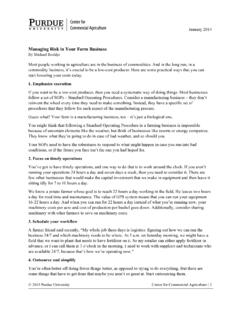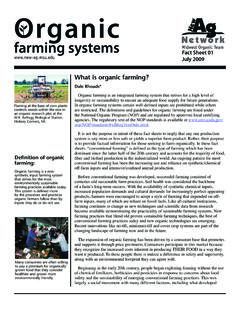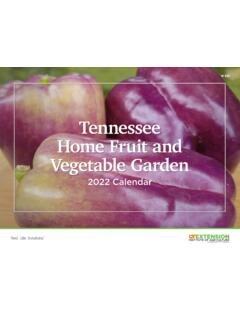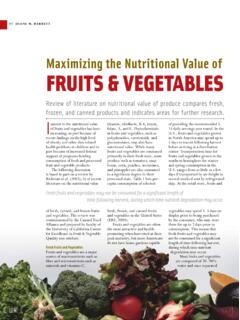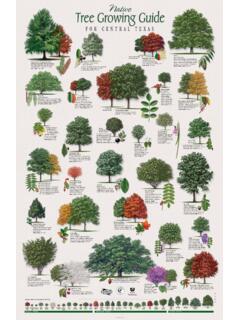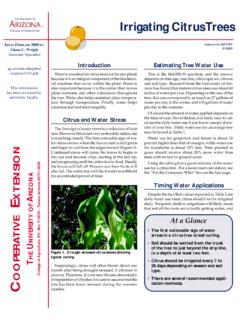Transcription of Midwest Fruit Pest Management Guide 2021 - 2022
1 Midwest Fruit Pest Management Guide2 021 - 2 0 2 2 ArkansasUniversity of Arkansas Cooperative Extension ServiceAG1304 IllinoisUniversity of Illinois ExtensionICSG-18 Indiana Purdue ExtensionID-465 IowaIowa State University Extension and OutreachHORT 3035 KansasKansas State Research and Extension MF3278 KentuckyUniversity of Kentucky Cooperative Extension ServiceID-232 MinnesotaUniversity of Minnesota ExtensionOhioOhio State University ExtensionBulletin 506 WisconsinUniversity of Wisconsin-ExtensionA4104 About This GuideThe Midwest Fruit Pest Management Guide 2021-2022 was developed by the Midwest Fruit Workers of the Midwest Fruit Workers Group are in the process of changing the format of this publication. We hope the new versions (for apples and grapes) make it easier for producers to find the accurate information they need for managing pests in Fruit crops.
2 We believe this new format provides readers with information that is concise and easy to understand. We are working to transition the rest of the Guide to this format. We welcome your comments, criticisms and suggestions. The print copy Guide of the Guide will be revised every other year. Updated version of the Guide can be found at: copies of this publication are available from the Purdue Extension Education Store, A free PDF download also is available from the Education Store or from your state s cooperative extension group wishes to acknowledge the organization abilities of Lina Rodriguez-Salamanca and Joseph Hannan in converting files into database format. Table layout and database development was supported by the USDA National Institute of Food and Agriculture, Crop Protection and Pest Management Program through the North Central IPM Center (2018-70006-28883).
3 This was a monumental undertaking that we hope will improve the updating and accu-racy of this Guide . Fungicide efficacy tables for all crops were compiled by Megan Heller-Haas and Janna Beckerman. This work was supported by the United States Department of Agriculture, National Institutes of Food and Agriculture (USDA-NIFA) grant number 2017-70006-27140 Midwest Fruit Workers Group also publishes companions to this Guide , including the Midwest Small Fruit Pest Management Handbook and Midwest tree Fruit Pest Management Handbook. Contact your state Cooperative Extension office for information about these Small Fruit Pest Management HandbookThe Midwest Small Fruit Pest Management Handbook is a companion publication to this Guide . It contains additional in-formation about control strategies for small Fruit diseases, insect pests, and weeds.
4 Pesticide safety, sprayer calibration, plant nutrition, and weed identification are also covered. Copies of the publication (Ohio State University Extension Bulletin 861) may be available from your state Extension office or from Ohio State University Extension Publications, 385 Kottman Hall, 2021 Coffey Road, Columbus, OH 43210-1044, 614-292-1607. You can also order it from Ohioline, tree Fruit Pest Management HandbookThe Midwest tree Fruit Pest Management Handbook also is a companion to this Guide . It contains additional information about pesticide safety, sprayer calibration, tree Fruit diseases, insect pests, and weeds, pesticide characteristics, growth regulators, spray adjuvants, and other related topics. Copies are available from your state Extension service. Legal Responsibilities for Pesticide UseThe pesticides suggested in this publication have been registered by the Pesticides Regulation Division of the Environ-mental Protection Agency.
5 At the time of printing, these pesticides were registered for use as indicated on the individ-ual product labels. These registrations can change at any keep informed of the latest updates on pesticide registrations, the Web version of this publication is updated regularly. It is available from the Purdue Extension Education Store, responsibility as a pesticide user is to read and follow all current label directions for the specific pesticide being used. Strictly observe the legal limitations on the use of these pesticides to prevent excessive residues in or on har-vested Fruit . All growers should read product labels, follow directions carefully, and observe pre-harvest intervals and application rates. Pesticide labels are available on the following sites: ; ; and through many suppliers all products listed in this Guide are registered in every state.
6 To be sure a product is registered in your state, check the National Pesticide Information Retrieval Service: of the pesticides suggested in this publication are on the EPA Restricted Use List, and users must be certified pri-vate applicators to purchase and apply these materials. Record-keeping requirements are more stringent for restricted use pesticides. Remember: The pesticide label is a legal document. 3 ContentsForward ..3 Apple ..13 Pear ..60 Cherry ..72 Peach ..87 Plum ..105 Special Problems and Pests of Stone Fruit ..111 Grape ..119 Blueberry ..151 Raspberry and Blackberry ..161 Strawberry ..172 Vole Control ..185 Fungicide PHIs and REIs ..187 Insecticide and Miticide PHIs and REIs ..188 Growth Regulator PHIs and REIs ..194 Chemical Weed Control in Fruit Crops ..195 Generic Pesticides.
7 218 Generic Herbicides ..221 Suggested Recordkeeping Form for Restricted Use Pesticide ..224 Fruit Grower Newsletters ..226 Pesticide Drift Communication Tools ..227 Using a Plant Diagnostic Lab ..227 Pesticide Applicator Safety Education Programs ..230 Pesticide Emergency and Poison Control Centers ..231 Conversion Factors for Weights and Measures ..232 ForewordCommercial Fruit production has become a highly skilled, technical profession. Concerns about pesticide residues, operator risks, and the environment dictate that all Fruit growers exercise extreme caution in the use of all pesticides, and indeed, all chemicals. The Environmental Protection Agency (EPA) has designated a number of Fruit pesticides as restricted use. Growers who plan to use these restricted materials must be certified as private requires that applicators understand the following: labels and labeling, safety factors, potential environmental concerns, identification of common pests encountered, pesticides and their use, proper equipment use, application techniques, and applicable state and federal regulations.
8 Training programs are offered to help you in certification. Contact your county Extension office for pest Management recommendations in this Guide have been formulated to provide you with up-to-date information about pesticides and their applicability to your problem. We suggest that you use this information to set up your own spray program. You should keep accurate records of materials used, application dates, areas treated, growth stages, and weather conditions. Sample record sheets are on pages 224-225. In case of questions, nothing beats a good set of records. The EPA requires records for restricted use pesticide applications. Some states may require records for general use pesticides ( , Kentucky has this requirement).Handling Pesticides1. Know the pesticide toxicity and act When mixing pesticides do not breathe the dust, powder, or vapor.
9 Always mix Do not use tobacco, eat, or drink when handling or applying Stay out of drift from spray or Rinse liquid containers with water at least three times and pour rinsate into spray tank as it is being filled. Punch holes in metal and plastic containers and crush. Dispose of these and all other pesticide containers where no contamination of crops or Midwest Fruit Pest Management Guide 2021-2022 Editors-in-Chief Janna Beckerman, Purdue UniversityLina Rodriguez-Salamanca, Iowa State UniversitySection EditorsKacie Athey, University of IllinoisJanna Beckerman and Elizabeth Long, Purdue UniversityRic Bessin and John Strang, University of Kentucky Christelle Guedot, University of WisconsinDonald Lewis and Lina Rodriguez-Salamanca, Iowa State UniversityMelanie Lewis-Ivey and Celeste Welty, Ohio State UniversityContributors University of Illinois: Kacie Athey, Mohammad Babadoost and Elizabeth WahleIowa State University: Joseph Hannan, Donald Lewis and Lina Rodriguez-SalamancaUniversity of Kansas: Rodrigo OnofreUniversity of Kentucky.
10 Ric Bessin, John Strang, Nicole W . Gauthier, Chris Smigell and Shawn Wright University of Minnesota: Annie KloddOhio State University: Melanie Lewis-Ivey, Celeste WeltyPurdue University: Janna Beckerman, Bruce Bordelon, Megan Heller Haas, Elizabeth Long, Stephen Meyers and Tristand Tucker University of Wisconsin: Christelle Guedot, Leslie Holland4water supply can occur. Do not reuse pesticide Use an adequate respirator and protective clothing, especially when mixing pesticides. Necessary protective equipment is listed on pesticide Have a buddy around when using acutely toxic organophosphates, just in For maximum safety, get an appropriate blood test before the season starts and test periodically during the Consult a doctor immediately if you develop unusual symptoms during or after spraying.

